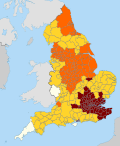| Statutory Instrument | |
 | |
| Citation | 2020 No. 1374 |
|---|---|
| Introduced by | Matt Hancock, Secretary of State for Health and Social Care |
| Territorial extent | England |
| Dates | |
| Made | 30 November 2020 |
| Laid before Parliament | 30 November 2020 |
| Commencement | 2 December 2020 |
| Revoked | 29 March 2021 |
| Other legislation | |
| Repeals/revokes | Health Protection (Coronavirus, Restrictions) (England) (No. 4) Regulations 2020 |
| Made under | Public Health (Control of Disease) Act 1984 |
| Revoked by | Health Protection (Coronavirus, Restrictions) (Steps) (England) Regulations 2021 |
Status: Revoked | |
| Text of the Health Protection (Coronavirus, Restrictions) (All Tiers) (England) Regulations 2020 as in force today (including any amendments) within the United Kingdom, from legislation.gov.uk. | |

Tier 1 Tier 2 Tier 3 Tier 4
The Health Protection (Coronavirus, Restrictions) (All Tiers) (England) Regulations 2020 (SI 2020/1374) is an English emergency statutory instrument that replaced the second lockdown regulations from 2 December 2020. As initially made, it brought back the three-tier legal framework first introduced by the first COVID-19 tier regulations in England (in effect 14 October – 5 November 2020), but with changes to the restrictions within each tier. The regulations are sometimes referred as the "second tier regulations" or the "all tiers regulations".
Contents
- Context and earlier regulations
- Legal basis
- Return of the tiers
- Restrictions on gatherings, all tiers
- Large gathering offence
- Exceptions to the restrictions on gatherings
- General and tier 1 exceptions
- Tier 2 exceptions
- Tier 3 exceptions
- Tier 4 exceptions
- Restrictions on leaving home in tier 4
- Reasonable excuses for leaving home in tier 4
- Exception 1: leaving tier 4 home necessary for certain purposes
- Movement between tiers
- Business closures
- General and tier 1 business restrictions
- Tier 2 business restrictions
- Tier 3 business restrictions
- Tier 4 business restrictions
- Linked households
- Linked childcare households
- Linked Christmas households
- Declaration on leaving the United Kingdom
- Reviews and expiry
- Enforcement
- Inconsistency in application by government officials
- British government staff Christmas parties controversy
- Inconsistencies regarding application of exercise rules
- Summary of main changes, by date
- Local authority areas in each tier, by date
- References
- Bibliography
- External links
- Data
Exceptions to the restrictions on gatherings were initially to be permitted during a 'Christmas period', defined as 23–27 December 2020. But following a continued rise in infections in London and the South East, parts of those areas were moved up to tier 3 (then the highest level) on 17 and 19 December. On 20 December, London and the tier 3 parts of the South East and the East of England were moved into a new top-level tier 4, with restrictions similar to those of the second lockdown regulations. [1] At the same point, the 'Christmas period' was restricted to Christmas Day only for tiers 1 to 3, and was abolished entirely for tier 4.
From 6 January 2021, further amendments moved all areas of England to tier 4 in what was described by politicians and the press as a "third lockdown".
The regulations were originally stated to expire on 2 February 2021, [2] later changed to 31 March, [3] but in the event were replaced on 29 March by the Health Protection (Coronavirus, Restrictions) (Steps) (England) Regulations 2021.










